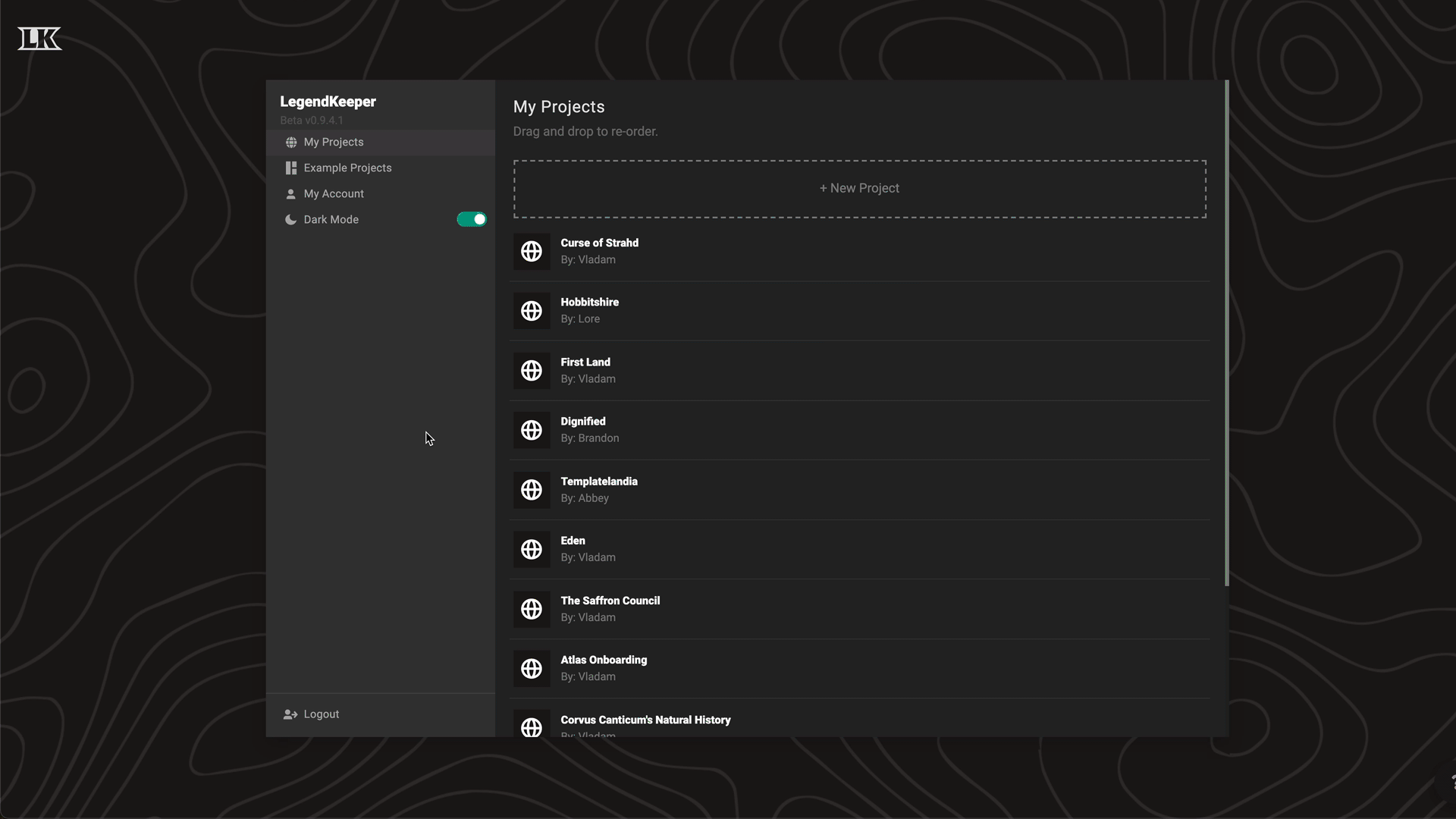There is so much more than meets the eye in LegendKeeper.
The simple user interface, and the ability to structure the wiki any way you want, ensure that people can create quickly, only adding more complexity as their project grows.
But the clean interface design sometimes leads to a "blank page" problem. It can be hard to understand just how powerful LegendKeeper is when you first start using it.
We created Example Projects to help show you what's possible. We recommend new users explore an Example Project to get a sense of what a more filled out project looks like in LegendKeeper.
Now here's the best part: Example Projects make use of LegendKeeper's unique content sharing infrastructure. When you enter one, you actually create a duplicate of the entire project and move it under your control. This means you can explore Example Projects actively: you can edit them, delete them, remix and build on them however you want!
To explore an Example Project, follow these steps:
- Log in to LegendKeeper (Don't have an account? Click "Join Beta" in the top right corner of this page.)
- Click on "Example Projects" in the left side menu.
- Click "Create example" on whichever project interests you.
The Example Project will be duplicated into your projects list ("My Projects") and you will be dropped into the selected project.

Read on if you are interested in learning more about how we wrote the projects.
Table of Contents
- Example Project #1: Questing in Selenia
- Example Project #2: Corvus Canticum's Natural History
- More inspiration from the community
Example Project #1: Questing in Selenia

Concept
The idea for this Example Project was to create the seeds for a campaign world for use in fantasy tabletop roleplaying games like Dungeons & Dragons. We used our custom maps by Augustinas Raginskis as inspiration for the world design. These same maps are available in the assets folder of every new LegendKeeper project.
The world also contains a D&D adventure called Quest: Nerezza's Jagged Crown complete with dungeon, descriptive text, magic items, and NPCs.
Creative Resources
This project was created using maps and artwork from the LegendKeeper collection, as well as other sources of inspiration.
- Maps and artwork created for LegendKeeper by Augustinas Raginskis
- Descriptive text for Quest: Nerezza's Jagged Crown by our friends at dScryb
- Monster and NPC inspiration from the generators at Here Be Taverns
- SRD stats for monsters from open5e.com. See the LICENSE for usage restrictions around OGL content.
More about dScryb
dScryb (2021 ENNIE Award Winner for Best Online Content) offers over 4,000 scenes of places, monsters, and spells, and the collection keeps growing. They’re just like boxed text from your favorite adventure book, but designed to be read-aloud in your own campaign.
We were able to use their search feature to rapidly find relevant descriptive text when we needed it. With only a few modifications to fit our story, we were able to drop it in to Quest: Nerezza's Jagged Crown to bring the scenes to life. Honestly, it saved us a lot of time.
They were kind enough to offer us a discount for LegendKeeper users. They have a free library, but if you decide you want access to the full library you can use the code LEGENDKEEPER at checkout to save $5 off your first payment.
More about Here Be Taverns
Here Be Taverns (2021 ENNIE Award Nominee for Best Online Content and Best Digital Aid) is a collection of random generators for fantasy roleplaying games. The generators are designed to inspire you - they provide just enough information and imagery to get you unstuck when prepping or when you need something quick at the table.
There are 6 free generators (Characters, Magic Items, Taverns, Monsters, Plot Hooks, and Locations) and 3 premium ones (Factions, Towns, and Encounters). If the premium ones seem useful to you, you can use the code SELENIA at checkout to save $5.
Example Project #2: Corvus Canticum's Natural History

Concept
The idea for this Example Project was to model an old-world encyclopedia. We used the Natural History by Pliny the Elder as our initial inspiration point. We also decided to limit ourselves to public domain art and demonstrate unusual uses of the Atlas feature in LegendKeeper.
Creative Resources
This project was created using entirely free resources (except for the Affinity image processing software).
- Curated Public Domain art was sourced on The Public Domain Review
- Other Public Domain art was sourced by searching Wikimedia Commons
- The color palette was generated by Coolors
- The font used in some of the maps was Frank Ruhl Libre
- The entire text of Pliny’s Natural History is in the public domain. We used this translation.
- Images were edited and processed using Affinity Photo and Affinity Design
More inspiration from the Community
Check out our Community Showcase to see some of the other things our community is creating with LegendKeeper.
